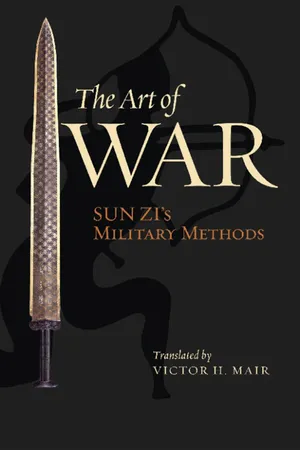
- English
- ePUB (mobile friendly)
- Available on iOS & Android
About This Book
Compiled during the Warring States period of 475-221 B.C.E., The Art of War has had an enormous impact on the development of Chinese military strategy over the past two thousand years and occupies an important place in East Asian intellectual history. It is the first known attempt to formulate a rational basis for the planning and conduct of military operations, and while numerous editions of the work exist, Victor Mair's translation is the first to remain true to the original structure and essential style of the text.
Mair's fidelity to the original, along with his insightful commentary and reliance on archaeologically recovered manuscripts, breaks new ground in solving The Art of War 's difficult textual and contextual problems. He confronts complex questions concerning the authorship of the work, asserting that Sun Wu, a supposed strategist of the Spring and Autumn period (770-476 B.C.E.) to whom the text is traditionally attributed, never existed. Instead, Mair claims that The Art of War coalesced over a period of around seventy-five years, from the middle of the fourth century to the first quarter of the third century B.C.E.
Mair also reveals the way The Art of War reflects historical developments in technological and military strategy in civilizations throughout Eurasia, especially in regards to iron metallurgy. He demonstrates the close link between the philosophy in The Art of War and Taoism and discusses the reception of the text from the classical period to today. Finally, Mair highlights previously unaddressed stylistic and statistical aspects and includes philological annotations that present new ways of approaching the intellectual and social background of the work. A phenomenal achievement, Mair's comprehensive translation is an indispensable resource for today's students, strategists, and scholars.
Frequently asked questions
Information
Table of contents
- Cover
- Half title
- Title
- Copyright
- Dedication
- Contents
- Epigraph
- Foreword
- Preface
- Principles of Translation
- Guide to Pronunciation
- Key Terms
- List of Abbreviations
- Précis
- Introduction
- Chapter 1. (Initial) Assessments
- Chapter 2. Doing Battle
- Chapter 3. Planning for the Attack
- Chapter 4. Positioning
- Chapter 5. Configuration
- Chapter 6. Emptiness and Solidity
- Chapter 7. The Struggle of Armies
- Chapter 8. Nine Varieties
- Chapter 9. Marching the Army
- Chapter 10. Terrain Types
- Chapter 11. Nine Types of Terrain
- Chapter 12. Incendiary Attack
- Chapter 13. Using Spies
- Appendix. The Pseudo-Biography of Sun Wu
- Notes
- Bibliography
- Index
- Series List